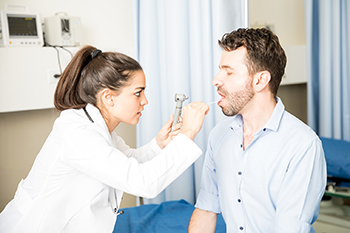Swallowing Disorders and Symptoms
 We provide evaluation, counseling and treatment for patients with oral and
pharyngeal swallowing disorders caused by a stroke, ALS, Parkinson's
disease, brain tumors, surgery, or radiation therapy to the neck. Our
diagnostic testing and treatment services include:
We provide evaluation, counseling and treatment for patients with oral and
pharyngeal swallowing disorders caused by a stroke, ALS, Parkinson's
disease, brain tumors, surgery, or radiation therapy to the neck. Our
diagnostic testing and treatment services include:
- Videofluoroscopy
- Fiber Optic Endoscopic Evaluation of Swallowing (FEES)
- Swallowing Therapy
Once a nurse or physician identifies a patient as having difficulty eating or swallowing, a consultation is requested from the speech-language pathologist. The therapist will first perform an evaluation at the bedside to determine if the patient is safe to eat or drink. Further tests may be recommended, which include procedures to visualize the swallowing mechanism and to determine whether foods or liquids are entering the airway.
Our goal is to find a way for our patients to eat and swallow safely to ensure that food and/or liquid goes down the esophagus and not the "wrong way" into the lungs. In many cases we can suggest diet modifications or recommend changes in head position that improve airway protection, allowing patients to continue to eat and drink even if they have difficulty swallowing or experience coughing or choking while eating and drinking.
Patients are referred to a gastroenterologist when they have difficult or painful swallowing especially after eating solid foods, experience a sudden, unexplained extreme weight loss or bring up phlegm after eating. Esophageal dysphagia may be indicated if solid food will not go down or if solids come back up after being swallowed.
Symptoms
Symptoms of a swallowing disorder may include:
- Difficulty getting food and liquid from the front to the back of the mouth
- Difficulty getting the swallow started
- Difficulty getting the food and liquid safely into the esophagus
- Coughing or choking while eating and drinking
